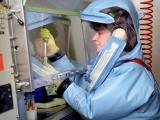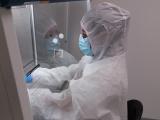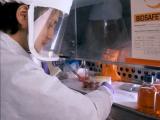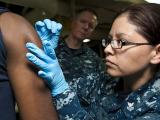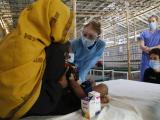Feb 14, 2012 (CIDRAP News) – The goal of an integrated national biosurveillance system to detect threats to human and animal health, called for in a presidential directive in 2004, is still a long way from reality and faces complex obstacles, according to a workshop summary recently published by the Institute of Medicine (IOM).
Participants in the workshop cited a range of problems that face the Department of Homeland Security's (DHS's) National Biosurveillance Information System (NBIS), from a lack of built-in authority to misinterpretation of the major obstacles and a lack of trust between the system and other agencies that generate relevant data.
William F. Raub, PhD, former science advisor to the US Health and Human Services secretary, called the integration and communication of information about biological threats a formidable challenge, according to the report.
"The collaboration, the sharing, and the integration are difficult in the context of multiple agencies with multiple missions and a rich variety of data sets, including areas where the data sets are nonexistent. . . . If it were easy, it would be done," he said.
The workshop was held last September, and an account of it was published recently under the title Information Sharing and Collaboration: Applications to Integrated Biosurveillance: Workshop Summary. The IOM is part of the National Academy of Sciences. Participants expressed only their own views, not those of an IOM committee, the report notes.
Program launched in 2004
DHS established the NBIS in 2004 as the nation's "first system capable of providing comprehensive and integrated biosurveillance and situational awareness," the document states. In 2007, in line with the 9/11 Commission Act, the National Biosurveillance Integration Center (NBIC) was set up within DHS to "identify, integrate, and analyze data to detect biothreats and disseminate alerts."
Since then, the NBIS and NBIC have been the target of critical reports from the DHS inspector general and the Government Accountability Office (GAO), the report recounts. In 2007 the former said the NBIS was falling short of its goals, in part because of a lack of leadership and staff.
The GAO called on the NBIC in 2009 to "define and communicate a common mission and purpose, define common procedures and strategies to align multiple agency cultures, and establish performance measures." In 2010 the GAO issued another report with similar recommendations.
Part of the workshop was devoted to presentations from federal, state, and local health agencies on their experience in sharing and obtaining various kinds of data, and another portion was a panel discussion of a fictional scenario involving a foodborne pathogen.
In another session, speakers discussed problems that have hindered the quest for integrated biosurveillance and proposed some ideas for moving the NBIS and NBIC forward.
Misreading the challenge
Leslie Lenert, MD, a professor of medicine and biomedical information at the University of Utah, said the original goal for the NBIS was to set up a "central fusion center" where all relevant information could be collected and analyzed, and the biggest investments were in "elaborate information systems."
However, the main problem was not technological, but rather a problem of communication and trust among different organizations, Lenert said.
He explained that the authorizing legislation didn't give the NBIC the power to "work top down" to collect information. Instead, other government agencies were expected to cooperate voluntarily under memoranda of understanding. Those agencies had to pay to send their data to the NBIC, a step that created a disincentive.
Now, according to Lenert, "NBIC is out of the loop of early information flows. It receives only final information products form partner agencies, does not have unique independent data sources, and has inadequate expertise and authority." Further, the Food and Drug Administration's and Department of Agriculture's emergency operations plans reveal that the NBIC has little or no role in the agencies' operations.
Lenert also said the 2009 GAO report showed that participants in a tabletop exercise repeatedly raised concerns about whether they could trust the NBIC with data from their own agencies.
Lenert went on to propose three possible solutions for moving the NBIC forward, including a top-down leadership model. The approach he favored was a performance improvement model, which would entail refocusing the NBIC on "curation of knowledge and information from evolving events for system monitoring and performance improvement."
With this model, he said, the NBIC "could capture and save the information state of each participating agency in NBIS on a daily basis, help other people monitor processes, find when processes are going astray, and alert the appropriate management."
Lenert concluded by saying it is a "myth . . . that all of the data can be gathered in to a single place to achieve a God-like view," according to the report. But the NBIC could fulfill its congressional mandate by improving the performance of the biosurveillance system.
A focal point needed
In another presentation, Michael M. Wagner, MD, PhD, of the University of Pittsburgh said integrated biosurveillance is a fairly new idea that is still diffusing into practice, and the rate of diffusion depends on factors like perceived advantages, compatibility, and complexity, according to the report. He is an associate professor in the university's Department of Biomedical Informatics.
Wagner asserted that biosurveillance "requires a focal point and authority if it is going to happen." The Manhattan Project and the Apollo moon mission had those features, but biosurveillance does not.
As a way to get the program moving, he suggested setting up a regional biosurveillance center for one or two cities, counties, or states. Focusing on a regional level would facilitate solving many of the technical problems of data integration and determining which other systems would be involved, and the system could serve as a model for what might be done at the federal level, he said.
"Integrated biosurveillance is a massive data and knowledge integration problem," Wagner said. "We can make the most progress toward solving it if we focus on one city."
See also:
Access page for IOM report on workshop on biosurveillance
Aug 16, 2007, CIDRAP News story on DHS inspector general's report on the NBIS


